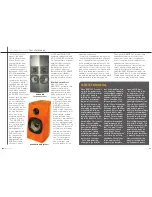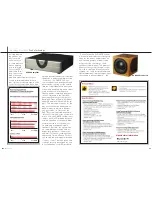
A
bout a year and a half ago, I got my first taste of Phase
Technology’s remarkably advanced and utterly unforgettable
DARTS speaker system, whose name is an acronym that
stands for Digital Audio Reference Theater System. The self-powered,
DSP-controlled system was something of a technical marvel, and it
even offered a fuzzy logic-driven room EQ system designed to optimize
response across multiple listening locations at once. Since I come from
the “simpler is better” school of thought, I am sometimes skeptical of
technically complicated solutions, but I had to admit that the DARTS
system sounded extremely transparent and that its high-tech EQ sys-
tem really worked. “A future TPV review subject,” I thought to myself.
Phase Technology DARTS 525:
Better Music Through Science
by Chris Martens
In a very real sense the DARTS 525 system is
the brainchild of three companies: Phase Tech-
nology, which contributed speaker/drive unit
design know-how, D2Audio, which contributed
Class D switching amplifier technology, and
Audyssey Laboratories, which provided a cus-
tomized version of its sophisticated MultEQ XT
automated speaker setup/room EQ system.
From the start DARTS 525 was conceived as a
self-powered or “active” speaker system where indi-
vidual drive units would be powered by dedicated
Class D amplifiers, with all traditional crossover
functions handled by digital signal processing
(DSP) engines built into the amplifier module. One
reason the speaker system performs so well is that
its drive units and amplifiers were literally designed
for each other. D2Audio’s Class D amplifiers are
capable of very wide bandwidth, nearly grain-free
resolution of textural details, lightning-fast transient
response, and high damping factors (which de-
scribe the amplifier’s ability to control driver motion
without overshoot). Phase Technology designed
the DARTS 525 drive units to take advantage of
these characteristics to the fullest extent possible.
Another advantage is that DARTS 525 is a
DSP-controlled speaker system where output
level matching and crossover frequencies and
slopes are controlled in the digital domain.
But the DARTS 525 system takes DSP further
still, applying DSP-driven frequency and time
response EQ curves at the driver level to yield
ruler-flat frequency response, ideal phase re-
sponse, and perfect time alignment between
drivers. In short, DARTS 525 would be a tremen-
dously accurate speaker system even if it did not
provide automated setup/room EQ features.
But DARTS 525
does
provide those features,
and they add an extra dimension to the system’s
performance. Unlike other EQ technologies,
Audyssey Laboratories’ DSP-powered MultEQ
system optimizes the speaker system’s in-room
frequency and time response characteristics for
multiple listener locations—not just for one central
“sweet spot.” Through a comprehensive set-up
and calibration process, it gathers room/speaker
response data from multiple seating locations,
collecting as many as 32 complete sets of mea-
surements. Then, the MultEQ system applies
fuzzy logic techniques to analyze the data and
calculate optimal frequency and time response
correction filters for each speaker in the system.
The term “fuzzy logic” means that the Audyssey
system does not simply average response data
as some competing systems do but rather takes
the more sophisticated approach of analyzing
data to identify specific “clusters” or patterns of
response problems within the room. Then, taking
a “whole system” approach, the system plots
channel-specific correction filters that together
work to compensate for room/speaker problems
across multiple listening locations at once. The
DARTS 525 system correction filters are extremely
precise, providing an astounding 512 individual
correction points per speaker, which result in
remarkably smooth in-room response curves.
The real genius of the system is that it
is an exceptionally accurate speaker that
does not try to achieve “perfect” response in
any one room location. Instead, it aims to
achieve very good response at multiple loca-
tions within real-world listening rooms—a
job at which it succeeds brilliantly.
The Technologies Behind the DARTS 525
Self-Powered, DSP-Controlled,
5.1-Channel Speaker System
ECHNOLOGY FOCUS
DFS-525C center channel
TPV
|
March 2007
42





















